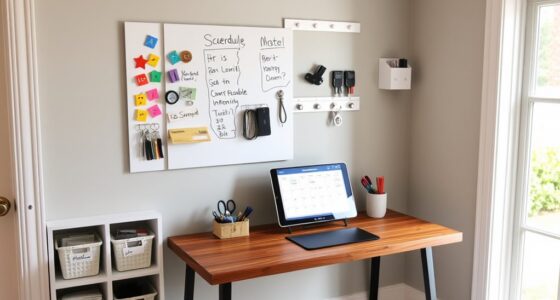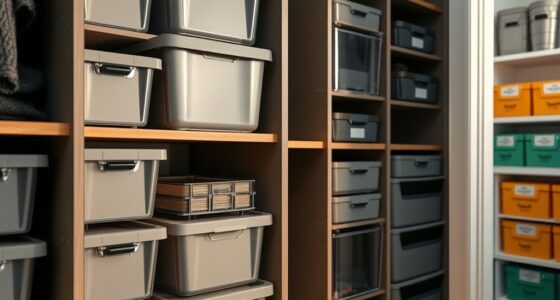Using uniform containers for everything might seem organized, but it actually creates more clutter. When you rely on identical boxes without considering their size, labels, or function, you’ll struggle to find items quickly. Overstacking or choosing containers that don’t fit your needs leads to wasted space and confusion. Without proper labeling or decluttering, your storage becomes overwhelming. To tidy up effectively, you need to understand the mistakes behind clutter buildup—keep going to learn more.
Key Takeaways
- Overusing uniform containers for everything hampers quick identification and leads to stacking errors, increasing clutter and chaos.
- Using mismatched or improperly sized containers causes wasted space and makes retrieval confusing.
- Not labeling containers clearly or consistently results in wasted time searching and misplacing items.
- Holding onto unnecessary or outdated items fills containers unnecessarily, adding to clutter.
- Neglecting regular decluttering and review causes accumulation of unused items, exacerbating storage clutter.
Overusing Uniform Containers for Everything
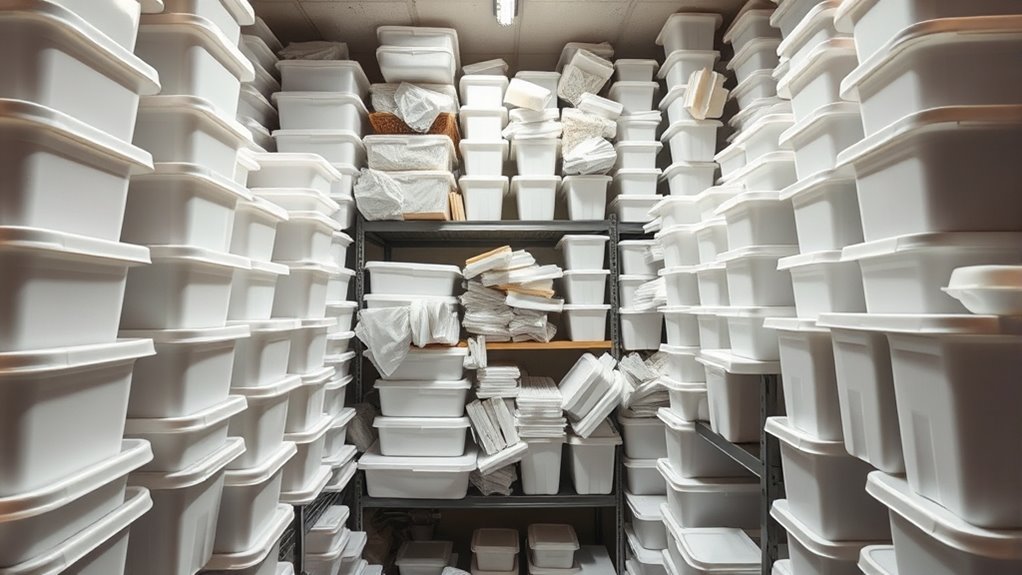
Many storage strategies rely heavily on uniform containers, but overusing them for everything can cause more problems than it solves. When you use identical boxes for all items, it might seem neat initially, but it often leads to confusion. You lose the ability to quickly identify what’s inside, wasting time searching for specific items. Visual cues and differentiation can help you recognize contents at a glance. Incorporating customized storage solutions tailored to specific items can enhance organization and efficiency. Uniform containers also encourage stacking without considering the size or fragility of contents, which can damage delicate objects. Additionally, overusing the same containers can make your space feel monotonous and harder to navigate. Instead of blindly sticking to uniformity, tailor your containers to suit the items they hold. Incorporating appropriate storage solutions can significantly improve organization, save you time, and prevent clutter from becoming overwhelming. Being mindful of storage design principles can further optimize your space and keep it clutter-free.
Ignoring Proper Labeling Techniques

Ignoring proper labeling techniques leads to confusion and wasted time when locating items. Without clear labels, you might rummage through multiple containers, wasting energy and patience. Proper labels help you identify contents instantly, saving effort and preventing clutter buildup. Use descriptive titles, dates, or categories to streamline your system. For example:
| Container | Contents | Date Added |
|---|---|---|
| Kitchen Tools | Utensils & gadgets | Jan 2024 |
| Holiday Decor | Ornaments & lights | Nov 2023 |
| Seasonal Clothing | Winter jackets | Oct 2023 |
| DIY Supplies | Paint & brushes | Dec 2023 |
This simple approach minimizes guesswork and keeps you organized. When labels are clear and consistent, clutter reduces and accessibility improves, making storage less of a chore.
Stacking Without Considering Accessibility

Stacking containers without considering accessibility can quickly turn storage into a frustrating puzzle. When you place heavy or rarely used items at the top, retrieving what you need becomes a hassle. You might find yourself climbing on a chair or moving multiple boxes just to access a single item. Poor stacking also risks accidents if containers topple over when you try to reach them. To avoid this, plan your storage by keeping frequently used items within easy reach and placing heavier or less-used items at the bottom. Use clear labels and designate specific zones for different categories. Proper stacking techniques are essential to preventing clutter from becoming an unwieldy mess. Incorporating effective organization methods can further optimize your storage and maintain order over time. Additionally, understanding storage safety can help prevent accidents and ensure a secure environment, especially when implementing accessibility principles to improve overall usability.
Choosing the Wrong Size for Your Items
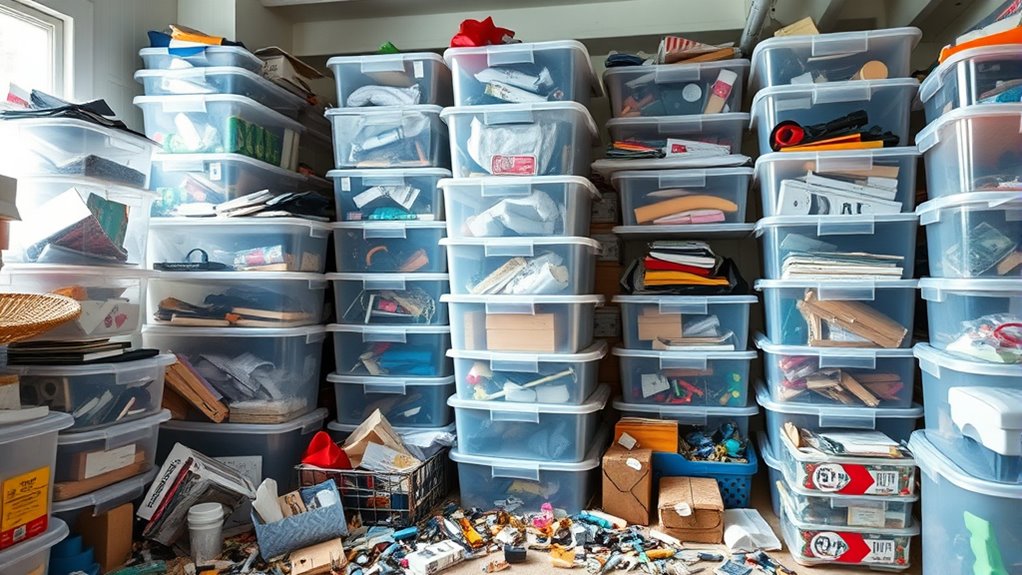
Choosing the wrong size containers or boxes can lead to wasted space and increased difficulty in organizing your storage. If your containers are too large, you risk leaving empty gaps that make stacking and locating items harder. Small containers, on the other hand, may force you to use multiple boxes for a single item, creating unnecessary clutter. Measure your items carefully before selecting containers to guarantee a proper fit. Think about how you’ll access and retrieve items; oversized boxes can make it tough to see what’s inside, leading to frustration. Proper sizing helps maximize space, keeps things visible, and simplifies retrieval. Avoid the temptation to go for the biggest or smallest option without considering your actual needs—this mistake hampers organization and creates clutter over time. Additionally, understanding self watering plant pots can help optimize storage solutions by keeping your plants healthy with minimal fuss, reducing the need for frequent watering supplies cluttering your space. Regularly reviewing your storage setup and adjusting container sizes as needed can further prevent production quantity variances that disrupt efficient organization. Recognizing the importance of breed characteristics can also guide you in choosing storage solutions tailored to specific usage needs.
Neglecting to Purge Unnecessary Items

Holding on to old items can clutter your storage and make it harder to find what you need. Overestimating how much space you’ll use often leads to wasted room and unnecessary costs. If you don’t regularly purge, you risk filling your container with items you no longer need. Additionally, neglecting to identify symptoms of breast cancer can delay early detection and treatment. Incorporating AI-powered data analytics can help identify which items are truly necessary, optimizing your storage space effectively. Regularly reviewing and applying market positioning strategies can further help in organizing items based on their importance and usage. Utilizing merchant services tools can also streamline your inventory management and reduce clutter. Employing analytics cookies can provide insights into your storage habits, enabling smarter decisions for space optimization.
Clinging to Old Items
Many people hold onto old items out of sentiment or a false sense of necessity, but clutter accumulates quickly when you refuse to let go. These items take up valuable space and make it harder to find what you truly need. Ask yourself if you’ve used or needed the item in the past year. If not, it’s probably time to let go. Consider the emotional attachment versus practical value. Sometimes, keeping something just in case isn’t worth the clutter. Use this decision matrix to evaluate:
| Item Type | Frequency of Use | Emotional Value | Action |
|---|---|---|---|
| Old clothes | Rarely | High | Donate or discard |
| Childhood toys | Never | High | Keep for memories |
| Broken gadgets | Never | Low | Recycle |
| Sentimental gifts | Sometimes | High | Preserve selectively |
| Outdated decor | Never | Low | Donate or discard |
Clinging to things stalls your space and progress. Additionally, decluttering techniques can help you make more informed decisions about what to keep or discard. Incorporating local resources like donation centers or recycling programs can also facilitate a smoother decluttering process.
Overestimating Storage Needs
Clinging to old items often leads to overestimating how much storage space you’ll need in the future. You might keep boxes, clothes, or gadgets just in case, but many of these things become unnecessary clutter over time. By not regularly purging, you assume you’ll need every item someday, which inflates your storage needs. This mindset causes you to allocate more space than necessary, filling containers with things you rarely use. Instead, evaluate what you truly need and use regularly. Be honest about what’s worth keeping and what can go. Regularly decluttering helps you avoid overestimating your storage needs, freeing up space and reducing clutter. Remember, holding onto everything just creates more chaos and makes it harder to organize what’s truly important. Additionally, understanding the concept of storage capacity can help you better manage your space and prevent unnecessary accumulation. Practicing mindful organization and effective decluttering techniques can further streamline your storage solutions. Incorporating a systematic approach to space management ensures that your storage remains functional and clutter-free. Taking a periodic review of stored items can also highlight what is truly valuable and what can be discarded, preventing overestimation of space requirements.
Failing to Establish an Organized System
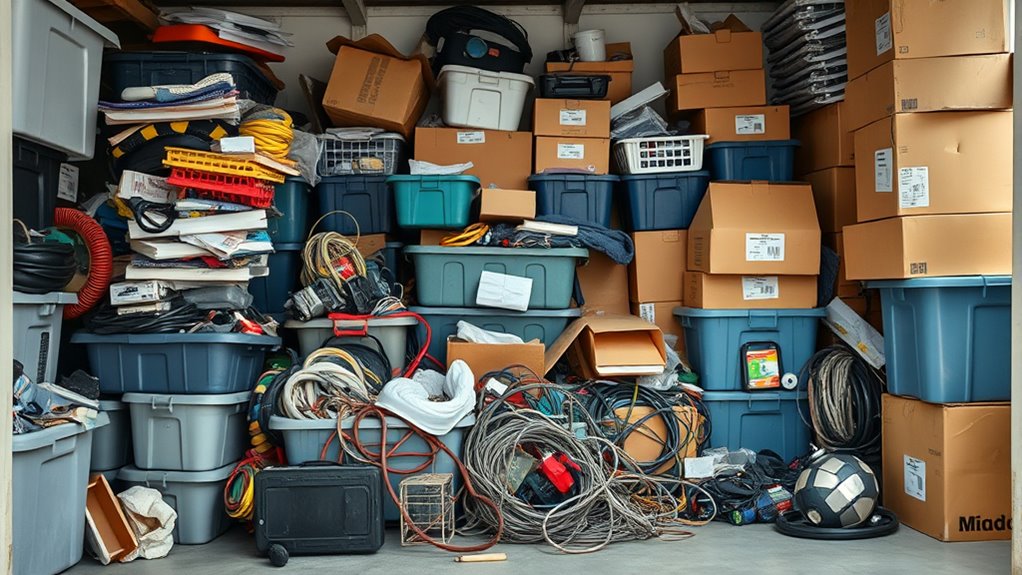
Without an organized system, your storage becomes chaotic and inefficient. Using inconsistent container sizes and skipping labels makes it hard to find what you need quickly. Establishing a clear system saves time and keeps your space tidy.
Inconsistent Container Sizes
When containers come in a variety of sizes without a clear system, it becomes difficult to organize and access your stored items efficiently. You might end up stacking large boxes on top of small ones or wasting space with mismatched containers. Inconsistent sizes mean you can’t optimize storage, leading to clutter and frustration. Small items may get lost in oversized containers, while smaller containers may be buried under larger ones. This chaos makes it harder to find what you need quickly. Without standardization, your storage system loses its effectiveness, turning what should be an organized space into a disorganized mess. To fix this, choose containers that are uniform or designed to fit together, so you can maximize space and keep everything accessible. Additionally, selecting compatible container sizes can help improve your overall storage efficiency.
Lack of Labeling Systems
A well-organized storage system depends heavily on effective labeling, yet many overlook this crucial step. Without clear labels, you waste time searching for items, causing frustration and clutter. Labels help you quickly identify what’s inside each container, making retrieval seamless. They also prevent doubling up on storage or misplacing items. When labeling, be consistent—use the same font, size, and placement. Include specific details like contents and date if relevant. Avoid vague labels like “miscellaneous” that only add to confusion. Investing a few minutes to label properly saves hours later. Proper storage organization encourages a disciplined system where everyone knows where things belong. Additionally, understanding headphone types and connections ensures your storage includes all necessary accessories and cables, preventing misplacement. Ultimately, proper labeling transforms chaotic storage into an efficient, clutter-free space.
Frequently Asked Questions
How Can I Prevent Overusing Uniform Containers in My Storage?
To prevent overusing uniform containers, you should evaluate the size and shape of your items first. Use a variety of container sizes to fit different items more efficiently, reducing wasted space. Label containers clearly for easy identification, and avoid stacking similar containers unless necessary. Regularly declutter and reorganize your storage, so you only keep what you need. This approach helps you maximize space and prevents clutter from building up.
What Are the Best Labeling Techniques for Easy Retrieval?
To make retrieval easier, you should label your containers clearly and consistently. Use large, legible fonts and color-coding to categorize items. Consider adding detailed descriptions and dates for better organization. Place labels on the front or top of containers for quick visibility. Regularly review and update labels to reflect changes. This approach saves you time, reduces frustration, and keeps your storage system organized and easy to navigate.
How Do I Optimize Stacking for Accessibility?
To optimize stacking for accessibility, you should prioritize placing frequently used items at eye level or in easy-to-reach spots. Use clear, consistent labels and organize similar items together. Avoid stacking too high, which makes retrieval difficult and unsafe. Incorporate storage solutions like modular bins or shelves that can be adjusted. Regularly reassess your setup to guarantee items remain accessible, minimizing the need for unnecessary rearranging and reducing clutter.
What Size Containers Work Best for Different Items?
When choosing container sizes, consider the items you store. Use small containers for jewelry or hardware, medium ones for kitchen supplies, and large bins for bulky items like blankets or sports gear. You should also match container dimensions to item sizes to prevent wasted space and make retrieval easier. Opt for stackable containers to maximize vertical space, and label everything clearly for quick access. This way, your storage stays organized and clutter-free.
How Often Should I Purge Unnecessary Items?
You should purge unnecessary items regularly to keep your space organized. Aim for a monthly or quarterly review, depending on how much clutter accumulates. When you notice items you haven’t used in months or no longer serve a purpose, dispose of them. This habit prevents clutter from piling up and makes it easier to maintain an organized environment. Staying consistent ensures your space stays functional and clutter-free.
Conclusion
By sticking to uniform containers and ignoring organization, you might think you’re saving time, but you’re actually creating chaos. Proper labeling and thoughtful stacking make your space functional, not cluttered. Sometimes, choosing the right size and letting go of unnecessary items is the key to clarity. Instead of more containers, focus on smart organization. After all, in clutter, you find more mess; in order, you find peace.


